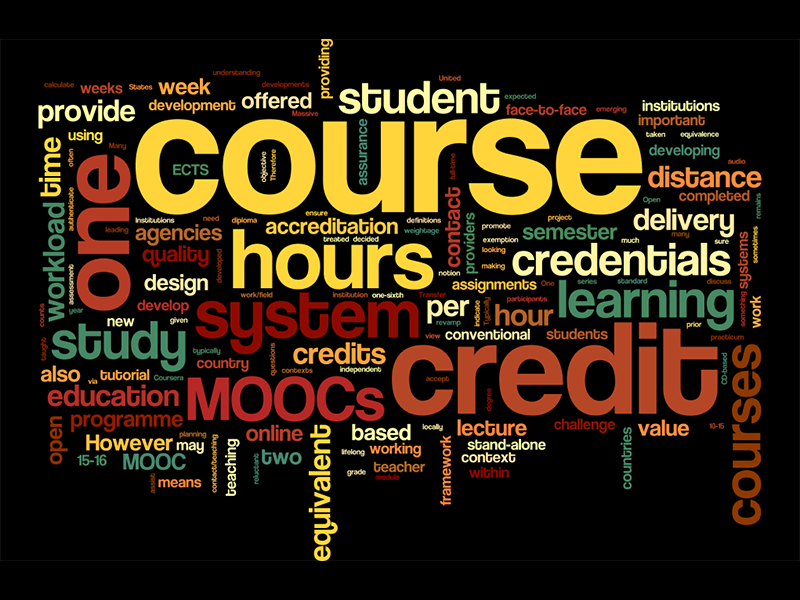
One of the major reasons that institutions and accreditation agencies are reluctant to accept Massive Open Online Courses (MOOCs) as equivalent to more formal university courses, is the notion of course and credit for credentials. We are often asked about how to provide credits for courses taken online through MOOC providers, and replying to such questions becomes difficult as there is no one way of looking at the issues around what constitutes a course or what is the uniform/acceptable definition of a credit, and how much of a course or credit is sufficient to provide credentials to the learners.
What is a course? A course in education is a unit of study that is offered by an institution and formally taught by one or more teachers over a period of time with an end-of-course assessment to provide a grade and/or certification. In some countries, a course is also referred to as a module (especially when a course is treated as a stand-alone programme leading to a certificate). So, a course is typically part of a programme (say a degree or diploma), and is also sometimes offered as a stand-alone course. In the conventional system of education, a course can have different weightage based on credit value. The nature of a course could be lecture, practicum, seminar, tutorial, project, independent study, etc.; however, from the course delivery point of view, a course could be delivered face-to-face or at a distance. For distance delivery, the course could be a print-based course, online (offered via a learning management system), CD-based, or a MOOC. When we speak of developing courses, we have an array of options before us in terms of delivery, but, we are still not sure what a course is. The credit- based system helps us to quantify a course and to indicate the amount of effort required from a student or teacher.
What is a credit? The definitions of credits differ again from country to country. In the United States, one credit is equivalent to 15-16 contact/teaching hours per semester. This means, about one hour of teaching time per week, where a semester consists of 15-16 weeks. Normally the students have to spend 3-4 hours for each one hour of contact sessions to read, discuss and complete assignments. In the European Credit Transfer System (ECTS), a credit is decided on the basis of student workload in contrast to teacher contact time in the US. A year of full-time study counts for 60 credits in the ECTS system, and the total workload is within the range of 1500-1800 hours, which means one credit is about 25-30 student study hours. Considering four hours of study time (including one hour of lecture) for a 15-week semester, a student in the US has about 60 hours of workload for one credit. Therefore, we can assume that one credit in the US is equivalent to two credits in Europe. In many other countries, the credit system is not very clear, and accreditation agencies locally decide on equivalence. In India, one credit in the conventional system is one hour of teaching (lecture or tutorial) or two hours of practical work/field work per week. However, in the open and distance learning system, one credit is equivalent to 30 student study hours, which includes working on the text, audio, video, assignments, face-to-face contact and so on.
Having a uniform standard for providing credentials for MOOCs is a challenge, but it is something that can be addressed, and a framework to calculate credit value of MOOCs can be developed easily, provided there is acceptance of such credentials. Typically, the duration of a MOOC is about 4-5 weeks, and about two hours of workload is expected per week from the participants making the course load about 10 hours, which is about one-sixth of a traditional one credit course. The idea of badges to earn micro-credits may be useful in this context. Institutions also need to look at developing systems for recognition of prior learning to provide exemption from courses, where a student has completed a series of MOOCs on a subject. However, the issue of credentials for MOOCs remains a challenge despite the development of technology such as signature tracking by Coursera, a programme to authenticate students. Many online education providers have been using a proctorial system to ensure that credentials are only given to those who deserve them.
While MOOCs have advanced the possibilities of enhancing the quality of open and distance learning, it is important to revamp the existing systems to design courses that are suitable for the new world. So, we are back to the question: what is a course? In the context of MOOCs, a course may be considered a short micro-unit of learning that can be completed within 10-15 study hours. However, in other contexts, using a credit value of the course to plan, design and cost courses would be important for planning and managing the process of course design, development and delivery. The micro-credit based courses could disrupt the education system in the 21st century by providing just-in-time training opportunities and promote work place-based learning. At COL, we are working to develop a framework and guidelines for quality assurance and accreditation of MOOCs. The objective is to develop an in-depth understanding of the emerging challenges to assist quality assurance agencies and institutions to be more open to new developments to support the lifelong learning paradigm.


